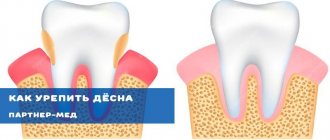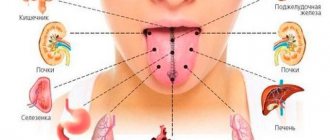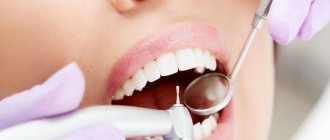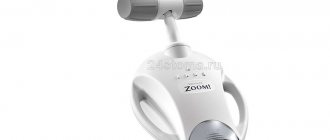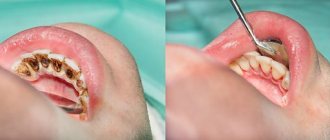How to behave after the whitening procedure?
- What recommendations should you follow?
- Soreness after a session: what does it mean?
- Dietary advice: what is prohibited?
- What is better to forget: bad habits
After a procedure that improves the shade of the dental surface, each of us has a rational question: “What to do after teeth whitening and what is it better to refrain from so that the effect lasts as long as possible?”
At first, after exposure, teeth become especially sensitive to various negative factors; they require high-quality and constant care. There is a list of rules that must be followed. It is their conscientious implementation that ensures that the dental rows remain white for many months.
Teeth whitening: harmful or not?
The procedure is part of cosmetic dentistry, but does not cease to be a medical service. That is why the answer to the question of whether teeth whitening in dentistry is harmful is obvious. When carried out correctly and using certified products and technologies, cosmetic teeth whitening does not pose a health hazard. This is the opinion of experts and researchers.
What recommendations should you follow?
You need to brush your teeth even more thoroughly than usual. Daily hygiene measures are carried out in the morning and evening, as well as after each meal. Duration of action – 3-4 minutes.
Use a soft-bristled brush, or even better, an electric one. It would be a good idea to get floss (or threads) and special brushes that tidy up the interdental spaces. Whitening paste or powder are indispensable assistants in maintaining the achieved result.
Have it professionally cleaned regularly. You should not ignore this service, because it allows you to:
- get rid of microbial plaque;
- touch those areas of the dental layers that are left unattended during home care;
- remove tartar;
- prevent periodontal diseases.
Hardware cleaning is recommended twice a year. After it, the doctor will certainly examine the oral cavity, which helps in the timely detection of all kinds of abnormalities.
Types of teeth whitening for hyperesthesia
One of the common areas of aesthetic dentistry is teeth whitening. Is it possible to carry out similar procedures for people suffering from highly sensitive teeth? It is possible to lighten the enamel, but here you will need a special approach.
Whitening in a dental clinic
sensitive teeth whitening into groups , then in modern dentistry such procedures are divided into professional ones, carried out in the dental office, and outpatient ones.
Professional whitening is carried out using a low concentration hydrogen peroxide solution (10%). The procedure is carried out in the following order:
- A special protective gel or rubber shield is applied to the gums;
- The surface of the teeth is carefully treated with the prepared solution;
- the composition is left on the enamel to act for 30-60 minutes, depending on the condition of the teeth;
- After this, the teeth are rinsed.
During outpatient whitening, the dentist takes an impression of the patient’s teeth, from which a mouth guard or dental attachment is made in the laboratory to individual sizes. The specialist applies a special gel with a whitening effect to the finished product.
To lighten the enamel, the patient must wear the manufactured structure at night every day. The average whitening course is 2-3 weeks.
Although this method requires a lot of time, in the case of sensitive teeth it is more gentle and safe.
Home whitening methods
You can also whiten your teeth at home. But in order to avoid unpleasant consequences and not provoke even greater tooth sensitivity, you should first consult a dentist before lightening.
At home, sensitive teeth can be whitened in the following ways:
- whitening strips. Strips with whitening gel are applied to the teeth twice a day for half an hour. The average course of treatment is 2 weeks. The result obtained lasts from 4 months to six months;
- lemon juice. The enamel will become lighter if you wipe it daily with freshly squeezed lemon juice. The result will be much more effective if during the whitening period you use toothpaste that contains lemon extract;
- baking soda. You need to mix soda (1 tsp) with a pinch of salt. Apply the resulting mixture to the brush and brush your teeth. Only very often such procedures cannot be carried out;
- raisin. Along with the fact that raisins have excellent taste, consuming them helps lighten the enamel.
You should also not forget about regularly rinsing your teeth with a special whitening composition. You need to rinse every time after brushing your teeth with toothpaste or using dental floss.
Soreness after a session: what does it mean?
Quite often people have toothache after whitening. What to do in such an unpleasant situation? Hypersensitivity is a natural phenomenon that can be disturbing on the first, or maximum on the second day after a whitening session. The reason for this is the active influence of dental instruments and drugs used to improve color.
Special products (rinses and pastes) will help to significantly reduce increased sensitivity and associated discomfort. If the pain is not severe, then it is advised to simply be patient and not eat very cold or hot foods.
If the pain intensifies and does not go away within 2-3 days, you should visit the dentist. Perhaps its cause was caries, gum inflammation or other serious pathologies of the oral cavity, aggravated by the manipulation.
Hygienic care rules
- Do not use a toothbrush with hard bristles - it will only increase the sensitivity that occurs immediately after the whitening procedure. It is better to give preference to a brush of medium hardness, since one that is too soft will not cope with removing plaque,
- Toothpaste should be free of abrasive substances that can damage the enamel. The best option is a paste to reduce hypersensitivity. It should be used for the first 2-3 weeks after whitening. Afterwards, it can be replaced with a paste that contains fluoride - this will be an excellent option for strengthening enamel and protecting against caries,
- After eating food (especially “coloring”), you should pay special attention to hygiene - use dental floss or a irrigator after each meal. And not only in the first days after whitening, but also in the subsequent ones - this recommendation should become a useful habit,
- Mouth rinses should not contain chlorhexidine, as it causes permanent staining of tooth enamel.
Even after whitening, you need to visit the dentist 1-2 times a year (but not earlier than six months later). Professional hygiene and removal of dental plaque will preserve the results and will be an excellent prevention of caries.
Women should avoid using lip gloss and bright lipstick for the first few days after whitening.
Dietary advice: what is prohibited?
Using drugs with an aggressive chemical composition that have the ability to change the shade of enamel and damage its texture is something that should not be done after teeth whitening.
List of unauthorized foods and drinks:
- black tea, coffee, red wine, bright-colored natural juices (pomegranate, cherry, etc.);
- chocolate;
- some spices (mustard, cardamom, soy sauce, ketchup, balsamic vinegar);
- fresh vegetables, berries and fruits - beets, dark grapes, currants, carrots.
A strict ban is imposed on the consumption of colored sodas (for example, cola). These are real killers even for completely healthy teeth, and after whitening they are especially harmful. The acids and pigments present in such drinks instantly nullify all the efforts of the dentist.
If it is not possible to refuse the listed products, then you should at least rinse your mouth with water after taking them. This way, staining and corroding components will not linger long on the surface of the teeth.
Whitening principle
At the moment, there are two types of whitening - office (professional) and home. Both methods are actively used to improve the color of teeth, but professional whitening is more effective. On the other hand, any type of whitening is based on the same principles. The basis of the bleaching agent is hydrogen peroxide or carbamide. When decomposed, free radicals are released, namely atomic oxygen, which effectively destroys dyes and pigments that accumulate in dentin. The effectiveness of whitening depends on a number of factors, including the concentration of the active substance and the regularity of the procedure.
What is better to forget: bad habits
Conducting a session forces a person to get rid of some addictions. Smoking does not benefit the body at all, and bleached teeth will turn black very quickly if you do not stop the addiction to cigarettes. The ingredients of tobacco smoke accumulate in the micropores of the enamel, which is exposed due to the procedure and becomes too vulnerable.
The habit of modern people to consume large quantities of caffeine also has a detrimental effect on the whiteness of treated teeth. It is recommended to direct your efforts to combat such “addiction”, because the aggressive pigments of caffeine-containing drinks instantly penetrate into the dental surface and neutralize the effect that was obtained through the brightening manipulation.
So, the amazing whitening results can be maintained for a long period. It is necessary to adhere to simple hygiene rules, follow a diet and overcome bad habits. A snow-white smile makes the face attractive, so your efforts will be completely justified!
How to treat tooth sensitivity?
First of all, it is necessary to determine the causes of increased tooth sensitivity; this will require consultation with a dentist. In most cases, the problem is solved after eliminating the main factors for the appearance of hyperesthesia - carious cavities, periodontal disease, after filling wedge-shaped defects and remineralization of damaged areas of enamel. However, quite often people who do not have dental diseases suffer from increased sensitivity. In such cases, hypersensitivity is the norm, however, you can fight it, because discomfort and unpleasant sensations reduce the quality of life and cause stress. In such cases, the dentist prescribes special medications, such as rinses and toothpastes, to reduce tooth sensitivity. Regular sessions of remineralization and strengthening of enamel, as well as a complex of vitamins and supplements also help cope with hyperesthesia.
If the cause of tooth sensitivity is their wear due to uncontrolled grinding and clenching, then a mouth guard for bruxism will be an emergency solution. However, this is not a treatment, but only a fight against symptoms. If you suffer from something similar, then even if you wear a mouth guard, be sure to consult a gnathologist.
How is the procedure done?
The procedure is performed in a dental chair. The patient is given a mouth dilator. A special gel is used. There is also a stationary lamp that affects the gel - it rolls up to the chair on wheels and is adjusted so that it is convenient to direct it into the oral cavity. The procedure is divided into three cycles - each lasting 10 minutes. After applying the gel, after these 10 minutes, you need to remove it, dry your teeth, then apply the next layer of gel. With all the preparations, the teeth whitening procedure takes approximately 40 minutes.
Preventive actions
Even the most gentle teeth whitening involves a demineralizing effect on the enamel and, accordingly, this process increases its permeability and irritability. To alleviate the condition and reduce the feeling of discomfort after the whitening procedure, you should follow the basic rules of prevention:
- Do not drink too cold or hot drinks or foods in the first 1-2 days after the procedure. Room temperature for food and drinks is considered optimal;
- exclude acidic foods from the diet;
- avoid chemical or thermal effects on tooth enamel;
- To brush your teeth, use a brush with soft bristles, which does not irritate the enamel coating when in contact;
- You cannot brush your teeth immediately after the whitening procedure; you need to wait several hours. When brushing, movements should be light and circular; in no case should you press on the surface of the teeth.
To quickly and effectively restore enamel after lightening, dentists recommend rinsing your mouth with special lotions with a high fluoride content. Such liquids reduce sensitivity and nourish dental tissues with minerals.
You should not whiten sensitive teeth yourself without first consulting a qualified professional. Such actions increase the risk of even greater enamel irritation and can lead to lengthy and complex treatment.
